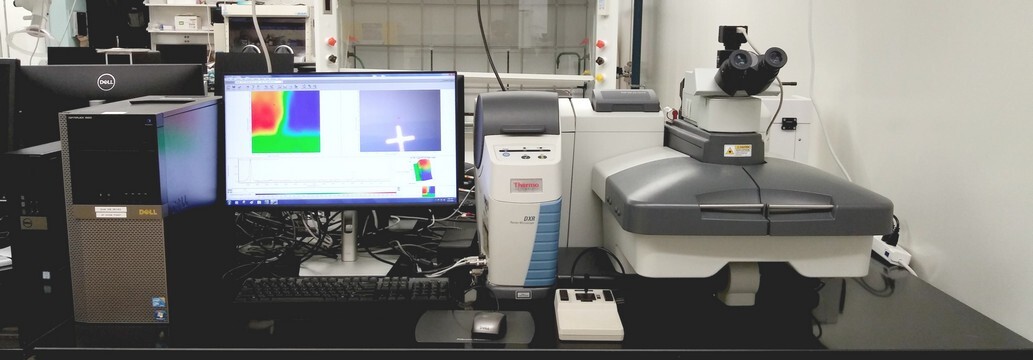Confocal Raman Microscope - Thermo Scientific DXR
Overview
Contact: Dmitry Koktysh
ESB 107 - Analytical
615-343-6757
Fee Structure
Get Access - Vanderbilt
Get Access - Non-Vanderbilt
Raman spectroscopy is used for non-destructive structural characterization and provides detailed information about chemical structure, crystallinity and molecular interactions. The Thermo Scientific DXR Confocal Raman microscope provides point and shoot Raman microscopy with exceptional sensitivity and spatial resolution for working applications. The sampling spot size of a microscope equipped with a 532-nm and 780-nm lasers, a 10X, 50X and 100X objectives and a 25/50- µm spectrograph apertures can be as small as just 0.6 µm in diameter. The instrument is able to deliver 1- µm x, y spatial resolution. In addition, confocal Raman microscope is capable of 2- µm precision depth-profiling. Spectral range can cover 6000-50 cm-1.
Capabilities
- 532 nm (10 mW) and 780 nm (24 mW) depolarized lasers with power regulated in 0.1 mW
- Microscope independently certified as class-1 laser safe
- 10X, 50X and 100X optical objectives
- Motorized mapping stage: 1 µm x, y spatial resolution, 2 µm precision depth-profiling
- Full-range grating 3500-50 cm-1, resolution 5 cm-1
- High-range grating 1800-50 cm-1, resolution 3 cm-1
- Extended spectral range for 532 nm laser to 6,000 cm-1 , resolution 8 cm-1
- Sensitivity (signal to noise ratio) 532 nm laser 1000:1, 780 nm high brightness laser 150:1
- Wavenumber accuracy ± 2.0 cm-1
- Proprietary auto alignment and calibration across entire spectral range
- Confocal and high-energy collection modes
- Confocal depth resolution — demonstrated as good as 1.7 µm on ideal sample
- Supports surface-enhanced Raman scattering (SERS) measurements
- Automatic fluorescence correction
- Research-quality Olympus viewing optics
- Proprietary algorithm for automated cosmic ray rejection
Applications
- Academic research – useful in material science, biological studies, and many applied research fields
- Nanotechnology – characterize graphene, CNTs, DLC coatings and other nanostructures
- Polymers – inclusions and gel defects, weathering effects, tie layers in laminates, and crystallinity
- Forensics – trace evidence
- Pharmaceutical – polymorphs, particulate contaminants, and diffusion studies
- Art Restoration/Conservation – identify and characterize pigments, resins, glazes, and inks
- Archaeology – characterize horn, shell, bone, and ceramic artifacts
- Solar – Silicon crystallinity; characterization of photovoltaic materials
- Failure analysis – characterizing particulates and small features on surfaces
- Gemology – rapid ID of colored stones, distinguishing natural and synthetic diamonds, characterizing inclusions and adulterants
Raman Microscope Resources

